
|
|
|||||
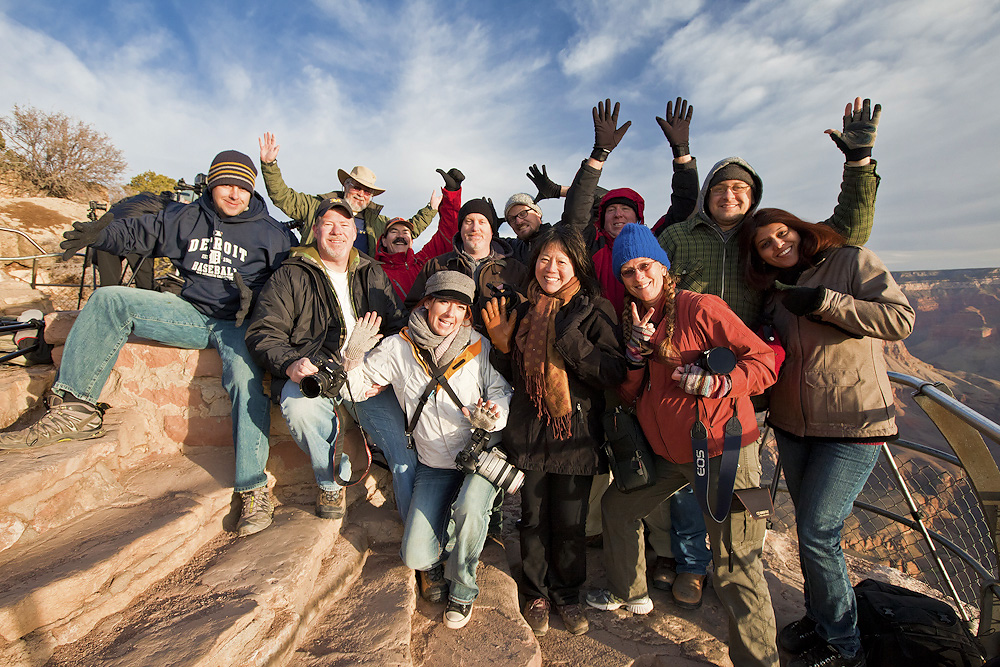
Arizona has a crack problem. Some would say it had a Grand crack problem…The Grand Canyon area of Northern Arizona brings in more people than any other National Park in the United States. Everyone comes here just to see the canyon. Many describe the experience as life altering, and the first time the see the canyon as one they'll never forget. Because of the magnitude and sheer enormity of the area, it's often hard for people to come away with meaningful photographs of the area, and many are so focused on the Grand Canyon, that they overlook all the other wonderful photographic opportunities that the area has to offer.
The Aperture Academy is here to help ease some of the stress of getting good photographs of the grand canyon, and also to help show students some of the other gems of the canyon country.
Instructors Brian Rueb and Ellie Stone met a group of eager photographers, many who are returning for workshop number two, three, four, or even higher with the Aperture Academy, in the Grand Hotel Lobby on the outskirts of the canyon for an orientation to the weekends events. The orientation covers weather, schedule of departure times, and what to expect while in the locations we would visit over the course of our two days together. The orientation also gives our instructors a chance to familiarize themselves with the classes' gear, experience levels, and personal goals for the weekend in terms of what they want to learn.
 The entirety of the first day would be spent in Page, Arizona a couple hours drive away visiting several iconic and amazing locations for photography. In order to be in Page at a reasonable time we would need a good nights' sleep to be ready for the long day ahead which begins promptly at 6am.
The entirety of the first day would be spent in Page, Arizona a couple hours drive away visiting several iconic and amazing locations for photography. In order to be in Page at a reasonable time we would need a good nights' sleep to be ready for the long day ahead which begins promptly at 6am.
The class assembled in the lobby, groggy, but ready for a day of photography. We loaded everyone up in our custom photography rig known as the ApCab, and set off in the dark towards the Navajo Reservation, and our first stunning stop of the day---Antelope Canyon.
Wind, rushing water, and many, many years have caused narrow cracks in the rocky Arizona desert to wear into narrow sculpted canyons hundreds of feet tall. A Navajo guide collects our admission and points to a narrow slit in the desert floor which serves as our entrance to one of the natural wonders of the world.
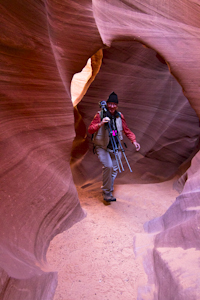 The class carefully makes its way through narrow staircases onto the sandy canyon floor. Above them twisting curves of bright yellow, red, and purple swirl as if shaped by a master confectioner. Light from the sun finds the opening in the narrow canyon top and filters sun into the depths of the canyon causing it to glow as if lit somehow from within. The class is excited and begins shooting almost immediately. It's up to Brian and Ellie to help the class stay in control and not get overwhelmed by the beauty. They help work with camera settings, when to bracket exposures, when a filter will work, what f-stop settings, and shutter speeds. Keeping them a part of the camera settings, helps them settle in and start to make compositions.
The class carefully makes its way through narrow staircases onto the sandy canyon floor. Above them twisting curves of bright yellow, red, and purple swirl as if shaped by a master confectioner. Light from the sun finds the opening in the narrow canyon top and filters sun into the depths of the canyon causing it to glow as if lit somehow from within. The class is excited and begins shooting almost immediately. It's up to Brian and Ellie to help the class stay in control and not get overwhelmed by the beauty. They help work with camera settings, when to bracket exposures, when a filter will work, what f-stop settings, and shutter speeds. Keeping them a part of the camera settings, helps them settle in and start to make compositions.
The canyon is a couple hundred yards long, and it's easy for people to get so into their shooting that they never make it to the end. Everyone finds a spot they like and dramatic images are coming along fast and furious. The canyon is narrow, and it's hard to set up, and compose due to the large number of other tourists visiting the canyon. This requires knowing the settings, and being part gymnast to set up in a crazy location to get just the right angle to get the best shot.
During April at a designated time the sun passes through just the right spot and a shaft of light pours into the canyon through a small archway in the rock and shines on the canyon floor. Just walking by the area one would not know the light beam existed, but when the local Indian guides fling sand into the air the particles catch the light, and the beam is visible. Our class sets up in the perfect spot, Ellie and Brian help with the settings, and then it's time to throw dirt.
One more!
Can you do it ONE MORE TIME?
JUST ONE MORE!
 Once everyone sees the light, they want to see it more and more, and given it's limited appearance, the stress to shoot it is overwhelming. Luckily the local guides are quite friendly and helpful, and stay around to throw dirt, despite having other tours to guide.
Once everyone sees the light, they want to see it more and more, and given it's limited appearance, the stress to shoot it is overwhelming. Luckily the local guides are quite friendly and helpful, and stay around to throw dirt, despite having other tours to guide.
We spend two hours in the park, but it flies by and feels like twenty minutes. We exit the canyon and our eyes strain to readjust to the bright sunny day after being in the cool dark canyon below.
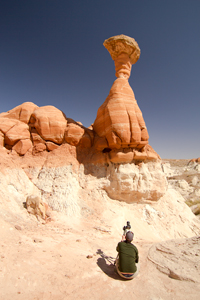 Everyone has worked hard for the past two hours and we're all ready for a nice lunch at a local Mexican Restaurant. During lunch the group talks about their experiences in the canyon, and as one would expect, photography is also a big topic of conversation. When everyone has recharged their batteries, it's time to get back to shooting! Yee-haw!
Everyone has worked hard for the past two hours and we're all ready for a nice lunch at a local Mexican Restaurant. During lunch the group talks about their experiences in the canyon, and as one would expect, photography is also a big topic of conversation. When everyone has recharged their batteries, it's time to get back to shooting! Yee-haw!
We drive outside of Page twenty miles to a trail known as 'The Toadstools.' The Toadstools are a section of carved canyon that has left behind what look like giant stone mushrooms. Also called hoodoos these interesting rock shapes create some great subjects for photography. Ellie and Brian lead the class on the ¾ mile hike to the location and then help them set up for some different types of composition.
With the sun now shining brightly almost directly overhead, we have a few options as to what is best photographed in the given lighting. Ellie works with some students on shooting the hoodoos with the sun peaking out from behind, when photographed with a very high aperture the sun creates a star effect, which looks quite nice in photos. Brian helps students work in monochrome, or shooting with very shallow depths of field. Students will focus on a rock in the foreground and the hoodoos in the background are left to be blurry, creating an intentional shift in focus to place interest where the photographer wants the viewer to look.
Everyone finds some great things to shoot, textures, shapes, foreground images, images without foregrounds, animal prints, the area has so much to offer. The brilliant blue sky looks intense mixed with the bright white and orange rock structures.
We make a brief stop at a local Navajo trading outpost, also called Wal-Mart where our class can get a snack or something to drink while we wait for sunset at our last location of the day---Horseshoe Bend!
 Horseshoe Bend is a dramatic arch shaped curve in the mighty Colorado River, that looks, well, like a horseshoe. The best vantage point is high above on a cliff overlook. This shot is not for those with a strong fear of heights, as the only way to get the entire curve in the image is to shoot with an ultra wide-angle lens and be RIGHT ON THE EDGE! Our class were all troopers, and got right out there, conquered an fear of heights they may have had and got the shots.
Horseshoe Bend is a dramatic arch shaped curve in the mighty Colorado River, that looks, well, like a horseshoe. The best vantage point is high above on a cliff overlook. This shot is not for those with a strong fear of heights, as the only way to get the entire curve in the image is to shoot with an ultra wide-angle lens and be RIGHT ON THE EDGE! Our class were all troopers, and got right out there, conquered an fear of heights they may have had and got the shots.
 The sun was intense, and a lack of clouds made getting balanced exposures difficult without using graduated filters, polarizers, and in some cases some bracketed shooting for highlights and shadow area. Horseshoe bend is great in that it is a magnificent viewpoint in any kind of weather, even without the clouds we had some tremendous light, and the students came away with some great images!
The sun was intense, and a lack of clouds made getting balanced exposures difficult without using graduated filters, polarizers, and in some cases some bracketed shooting for highlights and shadow area. Horseshoe bend is great in that it is a magnificent viewpoint in any kind of weather, even without the clouds we had some tremendous light, and the students came away with some great images!
When the sun had dropped far enough behind the horizon that the best light was behind us, it was time to bid Page farewell and make the long drive back to the Grand Canyon so the class could get a few hours sleep so we could be up and out by 5am in order to be at the Grand Canyons' edge to watch sunrise the next morning.
During the evening the flat empty skies filled with clouds, and as we drove into the park in the morning we could see the first glimpses of what was going to be a beautiful sunrise. Our van parked at Yavapai View, and set off to the small, railed, rock overlook that was just large enough to hold our whole group.
The sun began to crest the horizon and the shades of pink and orange and gold began to fill the sky. Brian and Ellie helped the students to work with grad-filters, and polarizers to get the best results. They also helped to select a warmer white balance to really accentuate the warm tones in the sky and canyon walls.
When the sun was up over the horizon, the light illuminated all the various shades of yellow, each representing another layer in the twists and turns of the Grand Canyon.
 Mather Point was the second stop, and while the sun was up, there were plenty of white clouds in the sky to help give depth and balance to the shots. The light was still warm and sun kissed the tops of the plateaus and vista points inside the canyon. In addition to the nice overall images of the canyon, the instructors encouraged the class to do close up detail shots of the texture in the canyon walls as it glowed with the warm morning light. Though the photography was excellent, people sometimes forget the canyon edge is at 8000ft elevation, and the slight breeze helped make the morning temperatures of 29 degrees quite cold. Everyone was ready for some coffee and breakfast!
Mather Point was the second stop, and while the sun was up, there were plenty of white clouds in the sky to help give depth and balance to the shots. The light was still warm and sun kissed the tops of the plateaus and vista points inside the canyon. In addition to the nice overall images of the canyon, the instructors encouraged the class to do close up detail shots of the texture in the canyon walls as it glowed with the warm morning light. Though the photography was excellent, people sometimes forget the canyon edge is at 8000ft elevation, and the slight breeze helped make the morning temperatures of 29 degrees quite cold. Everyone was ready for some coffee and breakfast!
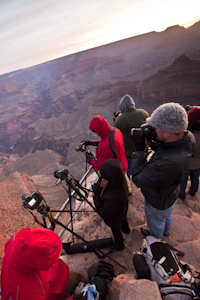 We made a brief breakfast run at the canyon cafeteria, and then set off for the hotel so people could catch a short nap, check out of the hotel, and grab lunch before meeting again in the afternoon for a brief lesson in image processing. Many students get quite comfortable with the technical side of making an image in the camera, but struggle when it comes to making that data come out on the computer like it did in their mind when they shot it. Even though the class was brief, the few tips and tricks Brian and Ellie shared with the class helped a lot of students get an idea of where to start with their images when they got back home.
We made a brief breakfast run at the canyon cafeteria, and then set off for the hotel so people could catch a short nap, check out of the hotel, and grab lunch before meeting again in the afternoon for a brief lesson in image processing. Many students get quite comfortable with the technical side of making an image in the camera, but struggle when it comes to making that data come out on the computer like it did in their mind when they shot it. Even though the class was brief, the few tips and tricks Brian and Ellie shared with the class helped a lot of students get an idea of where to start with their images when they got back home.
The afternoon session began at the Hopi House viewing area. A large stone house, made to look like the ancient Hopi dwellings, holds some interesting shapes and subjects to make images of. Old wagon wheels, cactus spines, small windows, textures of stone, all make for interesting subjects. In addition to the old structure, there are still ample views of the mighty Grand Canyon to keep people's fingers tripping the shutter.
Perhaps the most exciting part of the stop was getting to see one of the extremely rare California Condors sitting out on a stone perch high above the canyon floor below. All the condors are tagged, and tracked. The tags make photographing them a little less exciting, but just the chance to see one of these large scavengers in person is an experience everyone will remember.
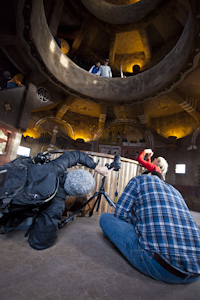 The final stop of the day is Desert View. This vantage point not only offers tremendous views of the canyon, but there is also an old stone watchtower, converted to a gift shop that provides not only a subject to shoot on the outside, but also from the inside. The spiral staircase, and stonework on the inside of the tower makes for some great photography. Warm light filters in from the outside, and creates a very pleasing mix of shape, contrast, curve, and light. The class really enjoyed spending the time leading up to sunset in the tower photographing.
The final stop of the day is Desert View. This vantage point not only offers tremendous views of the canyon, but there is also an old stone watchtower, converted to a gift shop that provides not only a subject to shoot on the outside, but also from the inside. The spiral staircase, and stonework on the inside of the tower makes for some great photography. Warm light filters in from the outside, and creates a very pleasing mix of shape, contrast, curve, and light. The class really enjoyed spending the time leading up to sunset in the tower photographing.
The clouds that greeted us in the morning had stuck around for the entire day, and if anything they had gotten better. Everyone was excited for the chance of getting a brilliant sunset to end the workshop. Desert View offers chances not only to photograph the canyon, with a segment of the Colorado River visible (something not possible at many viewpoints) but also the chance to make compositions that incorporate the tower in the image as well.
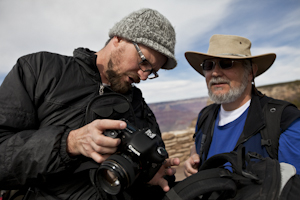 The sheer number of compositional possibilities at this location makes it an ideal place to end the workshop. Brian and Ellie help get everyone adjusted to the different types of shot possible, and then help them dial in composition, and camera settings. The sun is setting behind the group, which not only lights the canyon and tower with a warm glow, but also creates less contrast between sky and foreground, and lessens the need for grad filters. The polarizers help provide a bit more separation in the cloud and sky, and the farther the sunsets, the more intense the glow in the sky and on the castle.
The sheer number of compositional possibilities at this location makes it an ideal place to end the workshop. Brian and Ellie help get everyone adjusted to the different types of shot possible, and then help them dial in composition, and camera settings. The sun is setting behind the group, which not only lights the canyon and tower with a warm glow, but also creates less contrast between sky and foreground, and lessens the need for grad filters. The polarizers help provide a bit more separation in the cloud and sky, and the farther the sunsets, the more intense the glow in the sky and on the castle.
Shutters fire and smiles fill faces as the class sees the images appear on their screens. Brian and Ellie check the students and go over the histograms with them to ensure they all get images with plenty of data to edit properly when they get home. Sunset was tremendous and everyone got a great variety of successful images in their cameras. Simple shots of the canyon, tower, and sky…Images of the layers of the canyon fading in shade from dark to light blue…..simple shots of the canyon bathed in warm evening light….there were so many good images!
If we had to sum it up….we would say it was a GRAND way to end a GRAND adventure...
Until next time...
Brian, Ellie and the rest of the crew at the Aperture Academy.
If you'd like to join us at one of our workshops, you can find the schedule/sign up here.
 |
 |
 |
 |
 |
 |
 |
 |
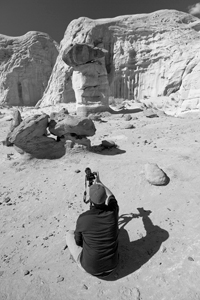 |
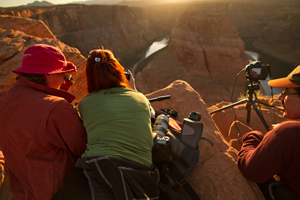 |
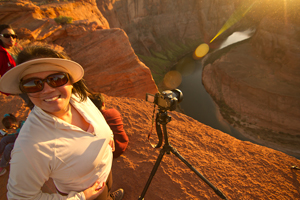 |
 |
 |
 |
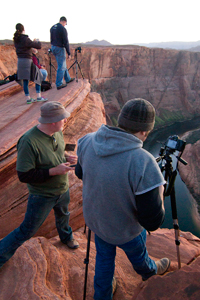 |
 |
 |
 |
 |
 |
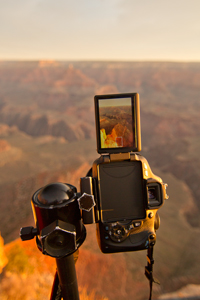 |
 |
 |
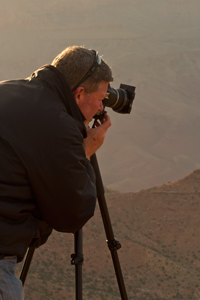 |
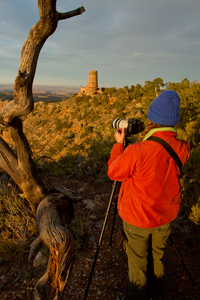 |
 |
 |
 |
 |
 |
 |
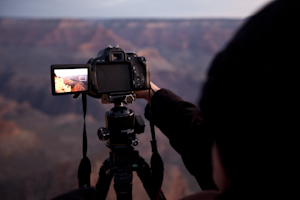 |
 |
 |
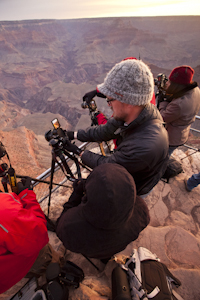 |
 |
 |
 |
 |
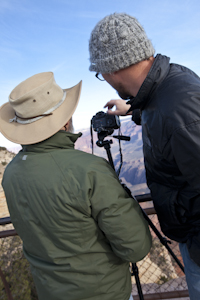 |
 |
 |
 |
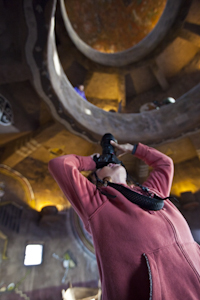 |
 |
 |
 |
 |
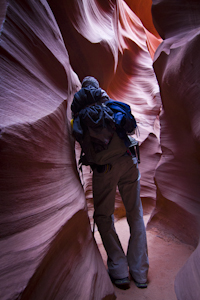 |
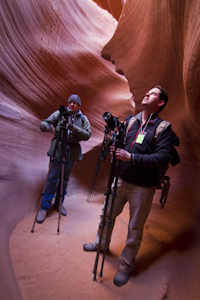 |
 |
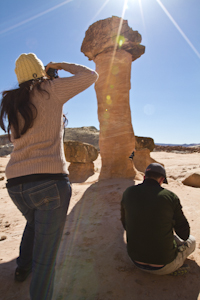 |
 |
 |
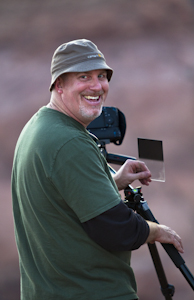 |
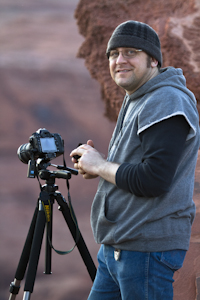 |
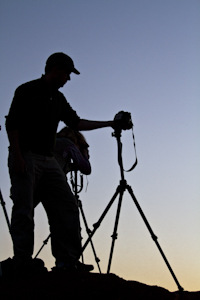 |
 |
 |
 |
|
 |
Other Cool Stuff→ Past Workshop Photos → 72dpi.com → How-To Articles → Photographer of the Month |
 |
Contact Us→ Contact Us → About Us → Site Map |
© 2009-2024 Aperture Academy, Inc.





